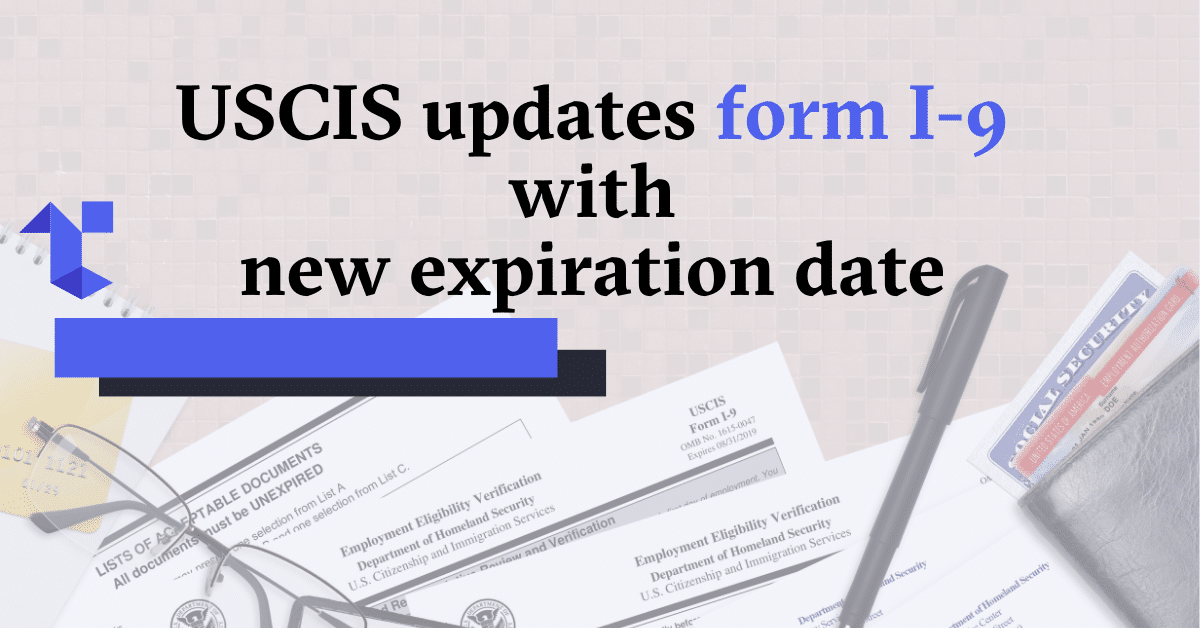USCIS updates Form I-9 with new expiration date
August 7, 2024
The U.S. Citizenship and Immigration Services (USCIS) has recently updated Form I-9, Employment Eligibility Verification, extending its expiration date to May 31, 2027. This change is significant for employers, who must comply with updated documentation standards to ensure the lawful verification of employment eligibility for their workforce.
What Are the Requirements to Use the New Form?
Starting from August 1, 2023, employers are required to use the newly released Form I-9, which might have listed expiration dates of either July 31, 2026, or May 31, 2027. Employers have the flexibility to use either version of the form up to its respective expiration date. However, it is highly recommended that employers transition their electronic Form I-9 systems to incorporate the May 31, 2027 expiration date as soon as possible. This proactive update should be completed no later than July 31, 2026, conforming to the expiration date of the previously issued Form I-9.
Why is Compliance Important?
It is imperative for employers to understand the importance of this transition. An updated Form I-9 helps to ensure that employees are eligible to work in the U.S. and that employers are adhering to federal law, thereby avoiding potential fines or penalties for non-compliance.
How Does This Change Streamline Employment Verification?
The changes in Form I-9 are part of a broader evolution to streamline employment verification and improve accuracy in documenting worker eligibility. Employers who rely on electronic Form I-9 systems need to work closely with their IT departments or software providers to update their systems accordingly. Switching to the new form requires ensuring that all data fields are correctly mapped, and that the system is programmed to reject forms after their expiration date.
What Revisions to Policies and Training Are Needed?
In addition to updating electronic systems, employers may need to revise internal policies and train HR staff to recognize and correctly handle the updated Form I-9. Ensuring that HR teams are fully trained reduces the risk of errors during the onboarding process, which can lead to legal complications or challenges in meeting compliance standards.
To facilitate a seamless transition, employers should:
- Conduct an audit of current Form I-9 usage to identify the version in circulation.
- Review and update electronic Form I-9 systems to reflect the May 31, 2027 expiration date.
- Communicate changes to all departments involved in the hiring process to ensure uniform compliance.
- Schedule training sessions for HR personnel to familiarize them with the nuances of the updated form.
- Perform regular check-ins and compliance reviews to ensure ongoing adherence to USCIS guidelines.
Employers must also remain vigilant regarding any additional updates or clarifications issued by USCIS. Staying informed about such updates can prevent last-minute scrambles and ensure that organizations maintain continuous compliance with federal employment eligibility verification laws.
What are the long-term benefits?
While transitioning to the updated Form I-9 may seem like a logistical challenge, the long-term benefits include enhanced accuracy in employment verification and minimization of legal liabilities. By acting promptly and diligently updating records, employers not only comply with federal mandates but also streamline their onboarding processes, offering a more efficient and legally compliant approach to workforce management.
Why Transition Early?
Employers should initiate the transition to the Form I-9 with the 2027 expiration date as early as possible. Completing this process by July 31, 2026, ensures compliance with USCIS standards and reinforces the organization’s dedication to lawful employment practices. Through timely updating of systems, revising policies, and training staff, employers can smoothly manage the transition while maintaining robust employment eligibility verification processes. Taking these steps not only safeguards the organization but also promotes a culture of compliance and integrity.
share this blog
STAY CONNECTED
Sign up for our newsletter for the latest Tesseon information.
Related Blogs
What our clients are saying about us
Disclaimer: The information provided on this blog page is for general informational purposes only and should not be considered as legal advice. It is advisable to seek professional legal counsel before taking any action based on the content of this page. We do not guarantee the accuracy or completeness of the information provided, and we will not be liable for any losses or damages arising from its use. Any reliance on the information provided is solely at your own risk. Consult a qualified attorney for personalized legal advice.

